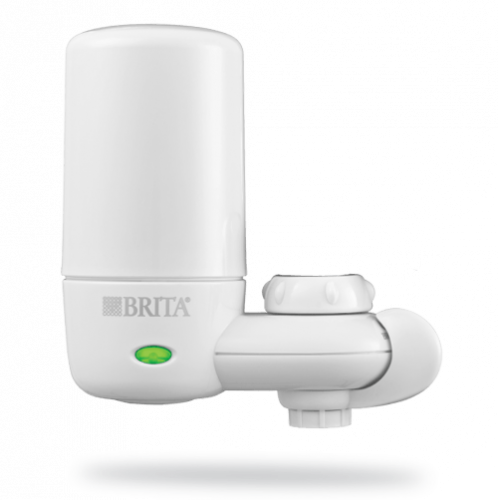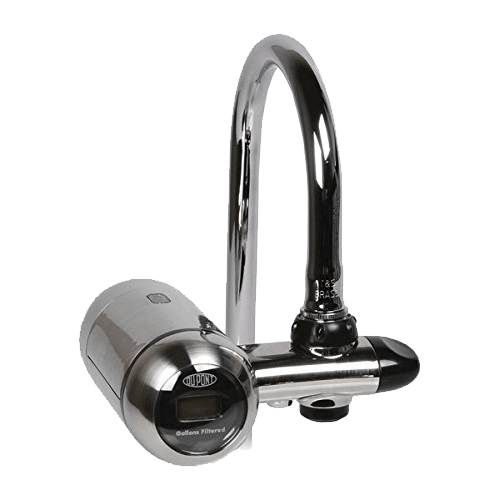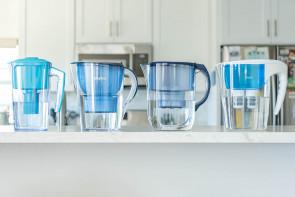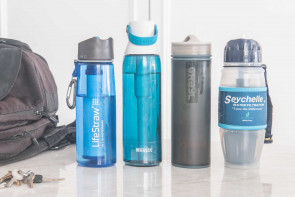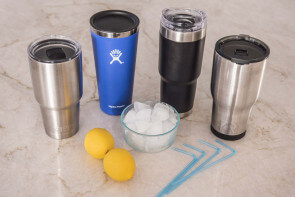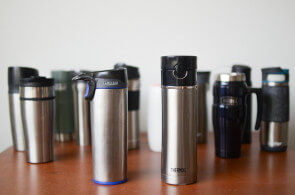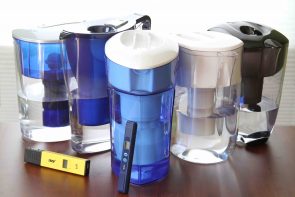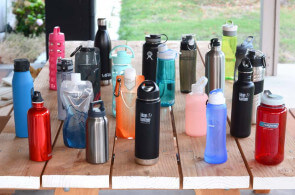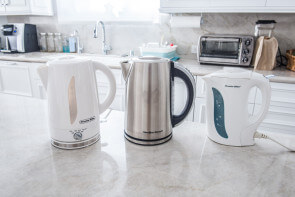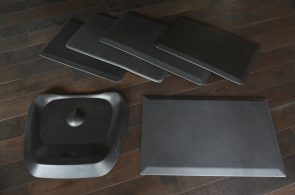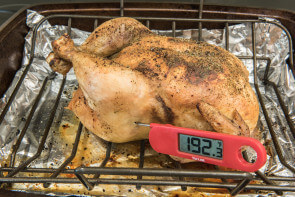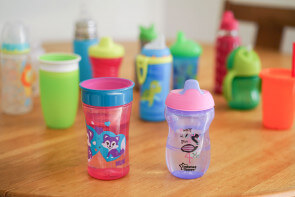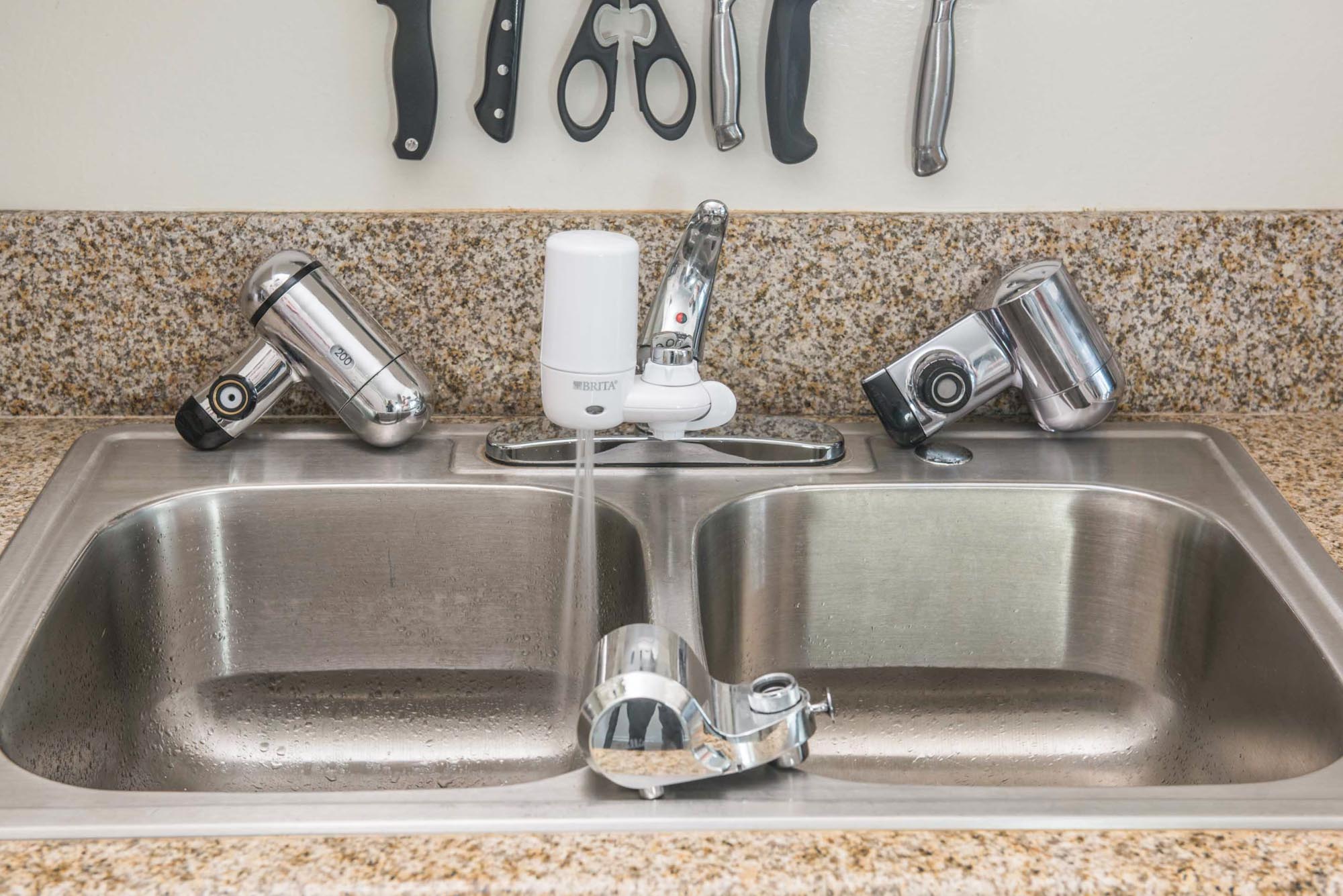
The Best Faucet Water Filters
After comparing lab tests from dozens of filter systems, we bought the four top faucet water filters and compared them with filtered water from pitchers, reverse osmosis and bottled water suppliers. The best faucet water filter was the Brita – FF100, with its compact size and excellent performance certifications. Brita also adds a multi-pattern spray and push-button filter replacement. Our runner-up is the DuPont – WWFM350, which will go longer between filter changes but isn’t as compact.
After comparing lab tests from dozens of filter systems, we bought the four top faucet water filters and compared them with filtered water from pitchers, reverse osmosis and bottled water suppliers. The best faucet water filter was the Brita – FF100, with its compact size and excellent performance certifications. Brita also adds a multi-pattern spray and push-button filter replacement. Our runner-up is the DuPont – WWFM350, which will go longer between filter changes but isn’t as compact.
Table of contents
- How we selected products to test
- Compare the best faucet water filters
- What do I really need to filter?
- The water test scam
- Important features to consider
- Carbon filters and how they work
- How we tested
- Top pick: Brita – FF-100
- Runner-up: DuPont – WWFM350
- The other finalists we tested
- The bottom line
How we selected products to test
To find the best water filter for faucets, we started with searches for reviews. The number of comprehensive reviews that compare the best on-faucet water filter systems is surprisingly low, with top hits giving little if any evidence they’d actually used the products or compared to competing products.
Faucet water filters are a niche category; they’re not as popular as the water filter pitchers we’ve tested but are easier to purchase and install than under-sink filtration systems. The big players from the world of pitchers are selling faucet-mount systems, but there are also hundreds of imitators cashing in.
The price of a mystery-brand filter is usually slightly lower than the faucet-mount water filter systems you’d recognize, but you’re giving up a lot of confidence for a few dollars per year. Some of the cheapest filters aren’t even specifying what kind of filter they use.
To ensure we were testing products that are trustworthy, we only bought filters that had been independently certified by NSF International. These certificates mean that a filter will perform as advertised even well beyond the rated life of the filter, and their laboratory controls are far more comprehensive and strict than we could hope to achieve in our test homes. NSF doesn’t make recommendations about the quality or suitability of a product, but they do tell you what a filter actually takes out of your drinking water.
The tricky part of choosing a water filter, even with that assurance, is that not every filter is given the same tests. A manufacturer chooses which compounds to test against, and NSF only lists a pass rating. If a certain contaminant was tested and the filter was poor at filtering it, neither the manufacturer nor NSF has to tell you.
We searched the NSF database for faucet water filters that had been tested and listed, and we bought all the most recent models that had been at least tested to remove lead.
We considered countertop units that attach to a faucet with hoses, but after comparing cost of ownership and the reliability and awkwardness (not to mention the increased up-front cost and the awkwardness of the hoses) we decided to stick with filters that mount directly to the faucet spout.
After finding the brands who had paid for comprehensive testing of filter performance, we checked customer reviews to see if there were features that stood out or had reliability concerns.
Sadly, all of the filters we found with trustworthy reviews have reports of failure. Any time you’re running water through small tubes and channels, mineral build-up is going to cause problems. The restricted flow of the filter only makes that worse. Still, we weighed the reports of filters popping off and splitting apart carefully when weighing the different models available.
Compare the best faucet water filters
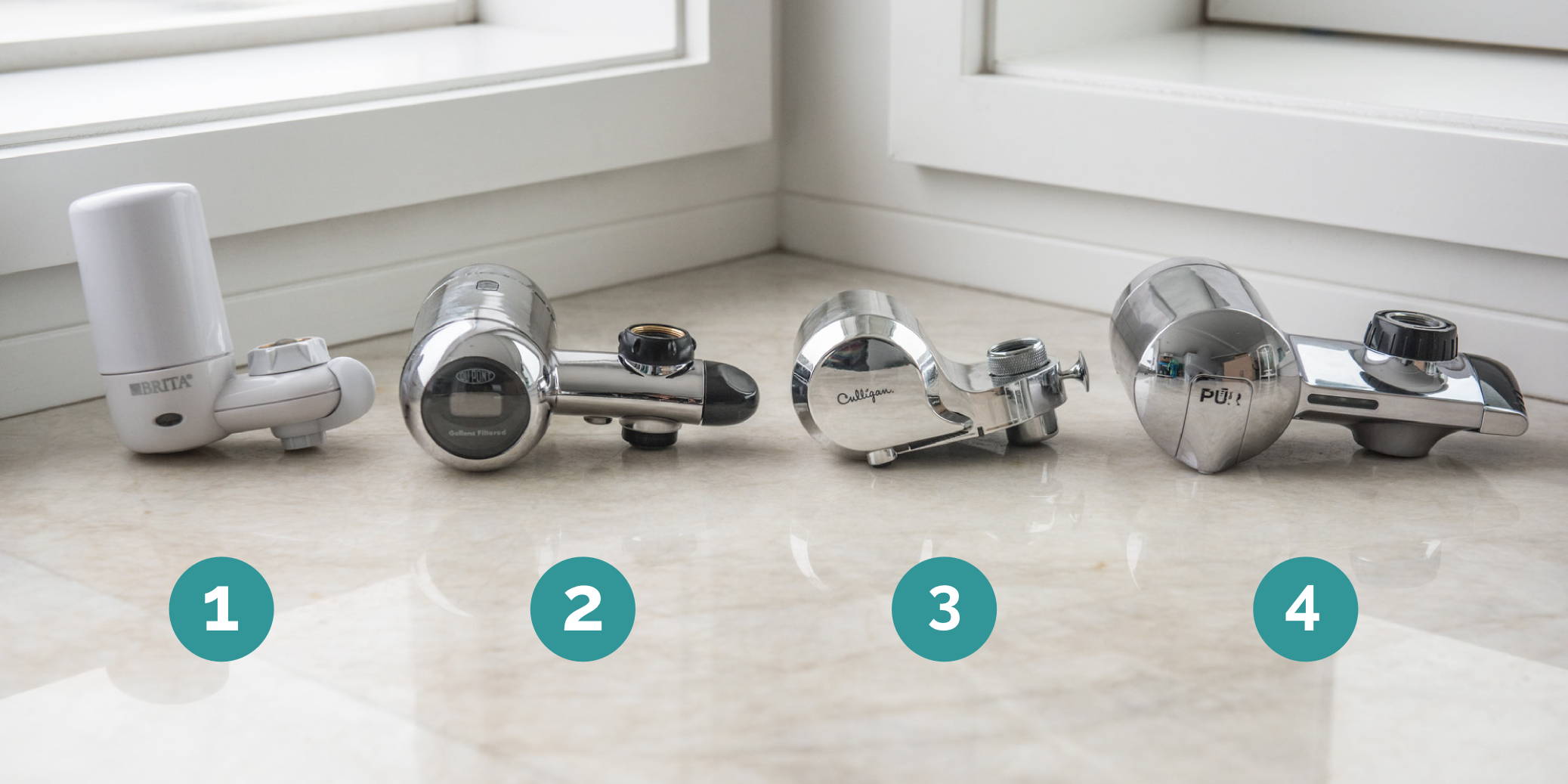
| Faucet Filter | Price | Annual Cost* | Flow Switch | Taste 1-5 | Compact? |
|---|---|---|---|---|---|
| 1. Brita - FF-100 | $52 | Three-position | ☆☆☆☆ | ☆☆☆☆ | |
| 2. DuPont - WWFM350 | $48 | FIlter/Unfiltered | ☆☆☆☆ | ☆☆ | |
| 3. Culligan - FM-100c | $42 | Auto-return | ☆☆☆☆ | ☆☆☆ | |
| 4. PUR - Advanced | $53 | FIlter/Unfiltered | ☆☆☆☆ | ☆ |
Do I really need a filter?
This is the hardest question for us to answer. In many ways, the answer for most people with internet access will typically be “you don’t need to filter anything, your water is safe.” But that’s not exactly the whole picture.
U.S. water safety
Water treatment is what makes drinking water safe for most of us. Some people have a private well that they need to monitor themselves, but the vast majority of the United States relies on a local water authority. You can look up who that is and how well they’re managing your water through the Environmental Protection Agency (EPA) database. This tracks who supplies water and whether contaminants have been found above allowed levels.
If your local water authority doesn’t mail it directly to you, you can also read a consumer confidence report, also tracked by the EPA. This lets you see not just a passing grade but also details about how close household water is to goals set by community health agencies. They’ll also report on “secondary” standards, which cover water-quality factors that aren’t considered health threats.
If you see a listed contaminant that’s too close to the limit for comfort, you can check for that contaminant on filter ratings before you buy.
Chlorine and taste
The main reason to filter drinking water is that chlorine — the disinfectant used in civic water supplies — doesn’t taste very good. The amount of chlorine used is regulated and checked by your water authority, but you can make most city water taste better by filtering out chlorine.
When we checked with brand-new and well-used water-pitcher filters, we found that even “used up” granular carbon filters are very effective at removing chlorine. This is all covered in NSF standard 42, which is a common certification for consumer water filters.
What about Lead pipes?
Water in our tester’s city is clean, but the local consumer confidence report says that over 90 percent of the homes have some lead in water tested from the tap. That’s all because of old pipes inside houses, not from the civic water supply. It’s about one third of the allowable level of lead but well above the public health goal.
This is a similar situation to homes in Flint, Michigan before the Flint water crisis, where switching water supplies caused old pipes, formerly safe, to release lead at unsafe levels.
In response to the Flint crisis, lead filtration has become one of the most heavily-advertised features of water filters. All of the filtration systems we recommend are specifically certified to remove lead.
NSF filter ratings
NSF International started as a branch of the School of Public Health at the University of Michigan. The name of the agency then was the “National Sanitation Foundation,” though they’re officially just NSF International these days.
NSF works with many food, health and safety agencies worldwide as a private certification agency. Along with other standard-setters like with the American National Standards Institute (ANSI) they establish what’s safe, then test and certify products ranging from bakeware to medical devices. They’re the main certifier of water filtration equipment, and they set tests standards based on input from various stakeholders, including manufacturers of water filters.
NSF isn’t an agency that recommends products, though — they only test and certify. If you see an advertisement claiming NSF testing, that advertisement doesn’t tell you the complete story of what was or was not successful in the product’s testing.
There are two standard tests for NSF-certified water filters, and many more that aren’t commonly requested or advertised:
- NSF/ANSI standard 42 certifies that a water filter can “reduce aesthetic impurities such as chlorine and taste/odor.” This is not linked to any health claim, and it’s an easy standard to meet with activated carbon. Basically every water filter more sophisticated than a mesh strainer meets this standard.
- NSF/ANSI standard 53 is the other common test, and in this case certifies that a filter can reduce levels of tested contaminants in water from unsafe to safe. Every filter we looked at has some NSF 53 certification, though not all are certified for the same contaminants; the manufacturer chooses what to test for.
- NSF/ANSI standard 53 – VOC is a subset of the safety test that covers volatile organic compounds (“VOCs”). These are compounds that evaporate quickly and require a different testing regimen: typically, VOC performance is tested by filtering water loaded with chloroform through the filter, and NSF infers the results for other contaminants based on past lab work. A longer list, then, doesn’t necessarily mean anything.
- NSF/ANSI standard 401 is another sub-set of standard 53. This test specifically covers 15 contaminants that aren’t yet regulated by health or water quality agencies. These include pesticides, flame retardants, detergents and pharmaceuticals. Only two of the brands we tested had been certified with these specific tests.
The fact that not every filter is rated for the same compounds makes comparing results tricky.
For example, it could be that one filter manufacturer has embedded some other filter medium in their activated carbon block so that it will capture metals better; if another manufacturer hasn’t advertised their filter removing that metal, it could be that the filter failed a test.
On the other hand, it could simply be that the filter manufacturers are counting on the public only looking at a few key contaminants. Testing for lead, for example, is a no-brainer after the highly-publicized Flint water crisis, but few consumers are actively seeking solutions for mercury contamination. Leaving mercury off the test list might be a cost-saving measure, or it could even be that the performance is just slightly poor enough (say, only 85 percent removed instead of 98 percent) that it sticks out on the data sheet and makes the filter look worse than it would otherwise.
The water test scam
Hardware stores often provide “free” water testing kits, but be careful: the hardware store test kits are specifically designed to get you to buy a reverse osmosis system by emphasizing the mineral content of your water.
Some salesmen will even use deceptive tests to convince you that you have things in your water that aren’t actually there. See this account of a chemist explaining false tests to a salesman who doesn’t even seem to understand what he’s actually testing.
Many consumers have been duped into paying for a system at above-market-value, and often on a store credit card with predatory interest policies.
Agencies like the Minnesota Department of Health and the Florida Attorney General have issued statements specifically advising consumers to be cautious about purchasing filters after seeing tests performed by installation companies. Class-action lawsuits are being fought all over the country, and one has even reached the Supreme Court.
You can pay an independent laboratory for water testing, but you still need to know what is a safe and reasonable amount of the contaminants they find, and you still have to decide what else you might want to improve.
Important features to consider
Installation: Faucet filters thread onto your faucet spout so pressure can force water through the filter. Each system comes with three thread adapters for all the common kitchen faucet aerator fittings, but none will work with a pull-out hand sprayer or other non-threaded spouts. Bathroom faucets won’t usually work, either.
Size and bulk: The systems we found all use approximately the same size of filter cartridge, but some are much bigger than others. A big filter system could get in the way when you’re trying to wash dishes or fill a stock pot.
Flow options: All faucet-mount filters allow you to bypass the filter. You don’t want to deplete the filter and settle for reduced water pressure when you’re washing dishes. Some filters automatically switch back to unfiltered water with a spring-return switch, while others offer multiple spray patterns in the unfiltered position.
Filter ratings: All of the filters we found use carbon block filters, so they’re comparable. They’re not all certified to remove the same contaminants, though. See our section on NSF certification for the details.
Vertical or horizontal filter: This is one of the biggest differences between designs. A vertical filter mount gives you a bit more room around your faucet spout, but they can drip a little leftover water from inside the filter. In comparison, horizontal-mount filters won’t dribble as much after you shut off the flow.
How carbon filters work
All of the water filter faucets in this category rely on carbon block filtration. That’s different from activated carbon granules, like you’d find in the budget pick from our water filter pitcher review.
A sheet of carbon sticks to other atoms and most carbon-based (organic) molecules, which also tend to be the worst-tasting. Activated carbon has so many microscopic pores, it has an active surface area of almost a million square feet per ounce.
Carbon block filters use compressed charcoal as a medium, which means the paths through the filter will capture most particles larger than a micron. It takes extra pressure to get water flowing through: Granule-based filters pass water much more easily and can use gravity-feed systems, but they also allow more contaminants to slip past.
Generally speaking, carbon filters are very good for capturing everything in water except dissolved minerals, metals and salts. Carbon filters are even great at filtering chlorine, which is typically the worst-tasting stuff in city water.
So, what about those dissolved minerals? Well, there’s good news and bad news. If you’re worried about heavy metals like lead, newer carbon filters work much better than traditional granulated carbon systems like the classic Brita pitcher. All the filters we tested are certified to handle lead, and most are also certified to take out mercury.
If you’re worried about fluoride and other dissolved minerals, you’ll have to use a more complicated system with another filter type alongside a carbon filter or a full-on reverse-osmosis system or distiller that removes basically everything.
The ion-exchange beads in a Zero Water gravity filters (and by many water softener systems) are the most effective way to get rid of the rest of the dissolved minerals in tap water. We started using a Zero Water to eliminate “white dust” mineral residue from hard water after testing for our humidifier review and essential oil diffuser review. It’s an effective solution that doesn’t require any expensive equipment installations. The more minerals you’ve got in your water, though, the more quickly a Zero Water filter will be used up.
If fluoride is the compound you’re specifically trying to eliminate, an activated alumina filter medium can be used in multi-stage filter systems along with carbon filters. The alumina requires a much slower flow rate to be effective, though, so this is not a common design, even in under-sink filter systems. Usually the best way to remove fluoride is a full reverse-osmosis system.
How we tested
Installation
Installing and using these filters was, thankfully, very easy. All the kits came with adapters for internal or external threading, but you will need to install it on a faucet with a threaded aerator of some kind. If you have a pull-out hand sprayer or other unique spout, these filters won’t be able to attach.
Cost of ownership
| Filter | Annual Cost* | Filter Life (gallons) | Filter Cost | Filter Life Indicator |
|---|---|---|---|---|
| Brita - ff-100 | $52.36 | 100 | $10.50 | Yes |
| DuPont - WWFM350 | $48.39 | 200 | $13.33 | Yes |
| Culligan - FM-100c | $41.74 | 200 | $16.49 | Yes |
| PUR - Advanced | $52.77 | 100 | $8.55 | Yes |
| Zero Water Pitcher | $150–$270 | 20–40 | $10–$15 | Taste, TDS meter |
| Brita - Long Last Pitcher | $54.72 | 120 | $8.24 | No |
| Bottled Water | $324.17 | N/A | $0.90 | N/A |
| Berkey - 1.5 gal | $236.43 | 6000 | $196.00 | No |
| *1 gal/day, 18 month body replacement | ||||
We looked at average prices for filters and compared the cost of filtering a gallon of water every day with each system. We also factored the cost of replacing the system itself every 18 months.
Most people will be able to run these systems for much longer than that, but if you get sediment or calcium building up inside, any of these could start to leak from the pressure forcing water through the carbon block. Also, you can’t replace the battery for any of the filter replacement lights.
Taste testing
We got our family of taste-testers to compare these filters to our top-ranked water filter pitchers, the Zero Water and Brita – Longlast. On the whole, the faucet filters were neck-and-neck with the Brita and just ahead of Zero Water. The average scores in the blind test were very close.
Dissolved solids and lab tests
| NSF-Tested Filter | Rated Life (gallons) | Mercury Removed* | Lead Removed* | Chlorine Removed | Microbial Cysts Removed | Percentage of Salts Removed (TDS test) |
|---|---|---|---|---|---|---|
| Brita - ff-100 | 100 | N/R | 99.3 | 97.5 | N/R | 1 |
| DuPont - WWFM350 | 200 | 96 | 99 | 99 | 99.98 | 8 |
| Culligan - FM-100c | 200 | N/R | 98 | 97.4 | N/R | 10 |
| PUR - Advanced | 100 | 96.5 | 99.7 | 96 | 99.95 | 0 |
| Zero Water Pitcher | 20-40 | 96.8 | 99.7 | 97.4 | N/R | 100 |
| Brita - Long Last Pitcher | 100 | 95.5 | 99.5 | 97.4 | 99.6 | 7 |
| *At pH 6.5 | ||||||
We used a conductivity meter to test for electrolytic dissolved minerals in our water, which includes everything from salt to sulphates. The faucet filters are leaving basically the same amount of dissolved minerals in our (fairly hard) Southern California water as the Brita – Longlast pitcher does. Even the best water filter for a sink faucet can’t match Zero Water’s party trick of removing all dissolved minerals.
Chlorine
We wanted to see if any of these filters would show a different result when it comes to taste’s biggest enemy, chlorine. Our chlorine test kit can detect a .01 part-per-million difference in total chlorine.
The tap water we tested had between 0.7 and 1 PPM of chlorine. We found that any water filter we try, no matter how long it had been in use, would remove all detectable traces of chlorine. The faucet filters gave the same great results.
Size

As we used these filters over our first week of daily testing, we quickly realized that size was a more important factor than performance for kitchen use. The filters didn’t prevent our filling a stockpot or washing dishes, but when we rinsed off a baking sheet or did other awkward sink-filling work it was more difficult with the bulky filter in the way.
You can remove and re-attach these filters without tools in most cases, so you could take off a filter if it gets in the way of filling or washing something on occasion, but it became quickly apparent that the smaller filters were easier to live with.
Top pick: Brita – FF-100
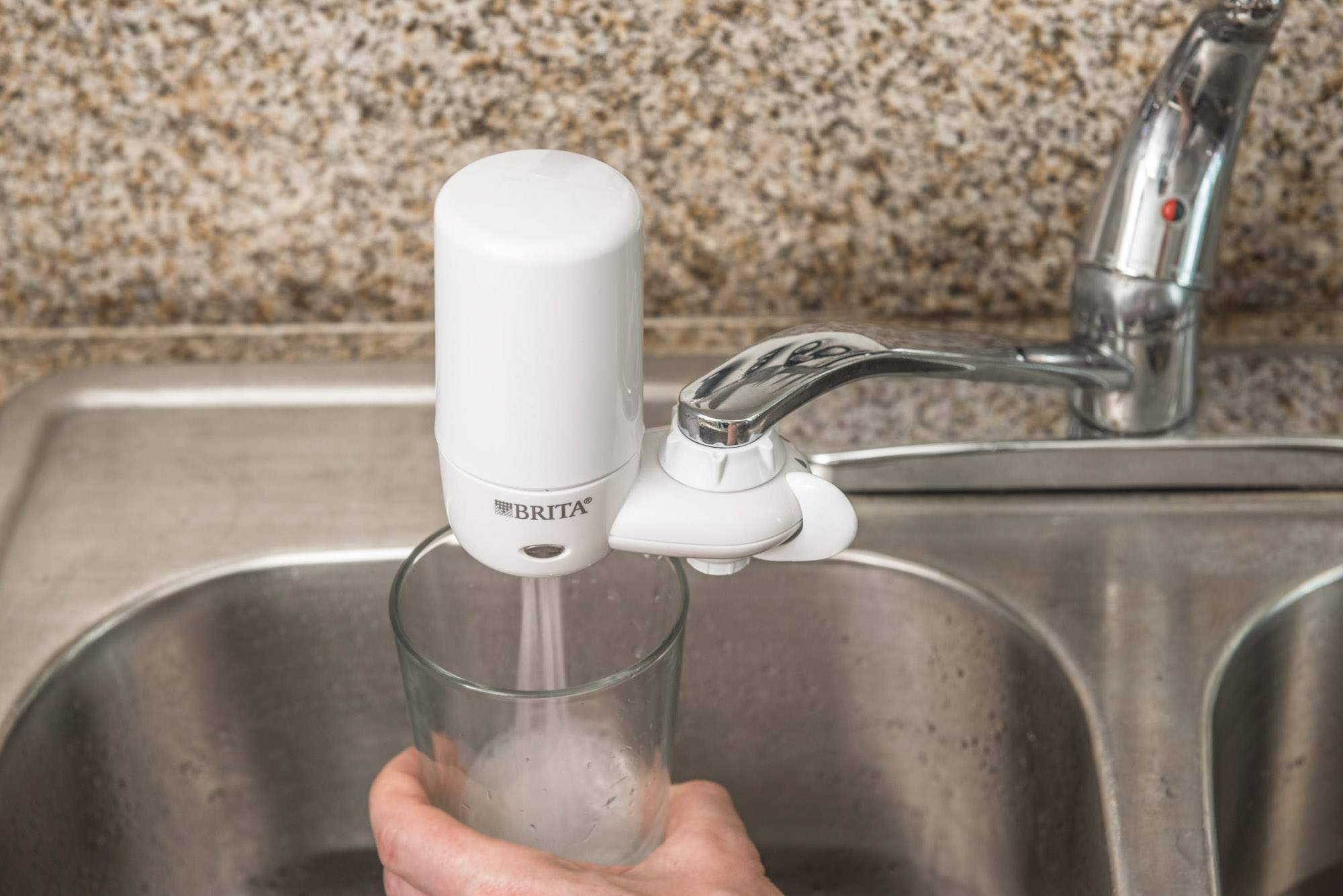
The Brita – FF-100 faucet water filter system squeaks ahead of every other filter system we tried in most respects. Brita has been around the home water filter market longer than anyone, and their experience shows in the refinements they’ve made to this system.
First and foremost, this is the most compact faucet filter we found. It’s still an awkward lump hovering over your sink, but the vertical orientation of the filter cylinder gives you a little bit more access than other designs. The fact that the filter output comes from the bottom means some dripping after you turn off the flow as gravity pulls the last few drops out of the filter block, but on the whole, it makes more sense than a horizontal filter.
This is an update of Brita’s old filter design, the SAFF-100. The plug-in filter cartridges are the same across old and new Brita faucet-mount systems, so performance is identical.
The main difference between the two systems is how the flow selection works: The old system used a wing-nut-shaped twist-knob, while the new system is a paddle that you push back and forth. The size and shape of the paddle is similar, but it’s slightly easier to push than to twist.
Brita also added a second spray pattern to the non-filtered flow outlet. A spray stream on your faucet, like the spray-type shower heads we’ve reviewed, typically uses less water to do the same washing and may be even better for rinsing if you have low water pressure.
Filter Performance
Brita’s certified filter performance is good. It doesn’t have the very best numbers in every category, but water-filter performance is tricky to evaluate: How many parts per trillion of atrazine or mercury is a problem if you’re drinking from a safe water source?
We relied mostly on the NSF tests to evaluate filter performance for this review, because, let’s face it, we can’t be more thorough than they are. More to the point, these filters are all basically the same. Carbon-block filters capture very small particles as well as most important chemical compounds that we worry about.
Brita does list certification for VOC removal, which means if you have dissolved solvents and gasses in your water, the Brita is certified to remove most of them. The fact that some filters don’t list VOC performance isn’t much of a concern, since it’s a standard benefit of using a carbon block, but it’s reassuring that Brita has paid to show what this filter can do.
Best Overall: Brita - FF-100
The compact design and extra features make this filter a stand-out winner. Brita has all the certificates to show how well this filter works, and the flow switch makes it easy to use at your main kitchen sink. So long as you've got a standard faucet, this is a good choice for on-demand drinking water.
Cost vs. convenience
The twist-open container designs used on the other filter systems aren’t difficult to open or close, but Brita’s design is more compact. These plug-in cartridges have a downside, in that they use slightly more plastic and need to be replaced more frequently.
Also, some users report that mineral build-up can make the seals leak and even prevent the filter from attaching securely. Mineral build-up will ruin any pressurized filter system eventually, so we factored an 18 month replacement cycle into our cost calculation.
Brita will pay for shipping to send in the filters so they can recycle them, but you need to collect the filters for years before you’d have a full shipment of five pounds.
Unlike the gallon-counting LCD screen on the DuPont, Brita just gives you a bare-bones LED indicator to tell you when to change the filter. We weren’t able to filter the full 100 gallons on ours before press time, but given that the digital readout on the DuPont wasn’t accurate, it’s hard to give either system any extra points.
Another downside, as you can see in this video clip, is that the filter outlet does take a few seconds to empty after each use.
Ultimately, the difference between the Brita and the long-lasting Culligan system worked out to about $11 per year, $52 vs. $41, when we compared average filter prices and estimated replacing the whole system every 18 months. (In worst-case hard-water conditions these systems start to plug up after that long.) That’s about the same price you’d pay using a Brita filter pitcher with a Longlast filter.
No matter which faucet filter you choose you’re adding an obstacle to your sink, but the Brita gives you the most room. It’s slightly more expensive in the long run, but the replacement filters are also easy to get.
Adding in the extra utility of a second spray pattern with an easy-to-flip selector, the Brita was somewhat more useful for washing dishes as well. When we had to decide on a system we liked using most, this was a pretty easy pick.
Key takeaways
- The Brita – FF-100 is our pick for the most convenient faucet water filter.
- A compact body and vertical filter take up less room in your sink than other designs.
- Vertical filters can drip a little bit after you use them.
- An extra spray pattern makes your faucet better, even when you’re not using filtered water.
- It’s only available in white.
Runner-up: DuPont – WWFM350

If you want maximum filter life and maximum performance, the DuPont – WWFM350 has you covered. The filter included with the FM350 is rated for double the number of gallons that Brita certifies for their filter, though the system costs slightly more overall. In the long run, you could save some money with the DuPont filters.
DuPont also makes this system in a chrome finish, which might go better with your kitchen than Brita’s white plastic.
Compared to the long list of solvents and organic compounds that Brita has tested their filter against, Dupont lists fewer results overall. They did get their filter certified to remove mercury, however, which is a notable absence on the Brita performance sheet.
There is one quirk about the performance sheet that we found disturbing: The results of the NSF International tests for both DuPont’s 100-gallon “extra protection” filter and the 200-gallon “ultra protection” are identical. The ultra protection filter is probably thicker to provide more surface area and last longer. It’s only a 50-percent price increase for a 100-percent increase in filter life, so it’s not a rip-off, but the labels imply a bigger difference than there is.
In terms of potential filter performance, let’s say this again: It would be surprising to see any meaningful difference between these systems we tested. We couldn’t even pick out anything distinctive about the taste from any of the water samples.
A unique feature of the DuPont is the flow counter: A small LCD screen on the side of the filter holder counts up the number of gallons passing through on the way up to the rated limit of 200. We weren’t impressed by the accuracy of the counter on the unit we bought: It only showed a few gallons used after the initial “flush” indicator went away and we used the filter for a few days of drinking water, making coffee and cooking. When we measured the meter with three gallons of water a week into our test, the digital “gallons filtered” display only ticked over after an average of one quart extra was filtered.
The major downfall of the DuPont compared to the Brita was size, though. Even if you don’t want the extra spray mode the Brita spout provides, the more compact size is a big help. DuPont made their system about 30 percent smaller than the PUR, though, so it’s not the worst offender.
If the counter had been more accurate or the design had been more compact this could have earned a stronger recommendation, but at the end of the day it’s just a bulky alternative to the Brita.
Key takeaways:
- The DuPont – WWFM350 filters twice as many gallons as the Brita for a few dollars more per filter.
- This is a more expensive system to buy up-front, so this is a longer-term investment.
- The gallon counter is kind of nifty, but it’s a big, clunky filter compared to the Brita.
- Comes in imitation nickel, chrome or white plastic finishes.
The other finalists we tested
Culligan – FM-100c

If you want the lowest possible up-front investment, Culligan’s FM-100c offers most of the benefits of the other filters for less than $20. It’s a mid-sized system, a little bit smaller than the DuPont but not as compact as the Brita.
Culligan’s FM-R filters are rated to last a full 200 gallons like Dupont’s, but they’re not as cheap or easy to find. If you have to pay more than the list price for filters, it might be cheaper to replace the whole filter system than to buy a refill. Culligan is still the least-expensive filter system over time, though, if you ever have to replace the whole unit because of a plugged-up switch or leaking seal.
Culligan’s system is simple. Rather than a knob or paddle switch, you get a spring-loaded plunger that switches flow between filtered and unfiltered spouts. This plunger returns flow to the unfiltered spout when you shut off the water, which is good for conserving your filter. That said, if you’re filling multiple drinking glasses or water bottles, it’s annoying that you need to switch it every time you turn off the tap. You’ll also have to wiggle it sometimes to get the flow entirely to the filter.
Ultimately, we don’t have any serious problems with the Culligan system, but it feels like every feature winds up being a compromise rather than a benefit.
Even the performance certificate feels like a cost-cutting exercise, with no VOCs tested and only three of the most worrisome compounds listed. It’s a safe bet that this filter performs almost the same as the others, but it seems the manufacturer wasn’t invested in showing that. The Culligan did show the lowest amount of dissolved solids in a conductivity test, but it was less than a 10 percent difference.
PUR – Advanced

PUR is one of the biggest filter names in the North American market, nipping at Brita’s heels. The PUR – Advanced PFM400H uses a top-tier carbon-block filter, but the device is just too bulky to win applause from our testers.
Of all the filters we tested, this was the largest. Any lump of chrome-painted plastic on the end of your faucet is going to get in the way to some degree, and we can’t say that this one was a particular problem, but you won’t forget it’s there.
Also, the fact that PUR hides the size and shape of their filter in the advertising and packaging by only showing it from the side lost them a few points of our esteem.
The flow-diverter switch is the one highlight of this filter: It’s a big, smooth, easy-to-flip lever. There aren’t any extra faucet-spray features like Brita has, but it does feel nicer than the other filters in that one regard.
This is the mid-range model from PUR’s newest lineup, and at about $32, it’s on the upper end of the range we tested. The filter only lasts for 100 gallons, but they’re slightly cheaper than the Brita refills. Since the unit itself is so expensive, the real gamble is that the body might plug up with mineral residue and start leaking before you see any benefit from the cheaper filters.
PUR does have a Bluetooth-enabled version of this system, but there are almost certainly better ways to track your water intake than a water filter app. It’s nice to have a definite number for the life of the filter, but we don’t have much confidence that the flow meter on PUR’s system would be more accurate than DuPont’s.
The PUR – Advanced model we tested does have one premium feature we were eager to try: The RF9999 “MineralClear” filters are supposed to add a small amount of dissolved minerals back into your water after it passes through the carbon block.
We couldn’t really taste a notable improvement, though the water from the PUR system did have about five percent more dissolved minerals than the average. Note that that’s in a range of 260 to 290 parts per million of dissolved minerals, fairly hard water that was basically unchanged by the other filters. You don’t have to worry about a faucet mount system taking away all the benign or beneficial minerals the way you do with reverse osmosis or a Zero Water system.
Pur’s MineralClear filters are certified to take out more contaminants than the other three filters we tested, with basically the same test certifications as DuPont. This is a good filter, but it’s not obviously doing more than any other carbon filter to give you clean water.
The bottom line
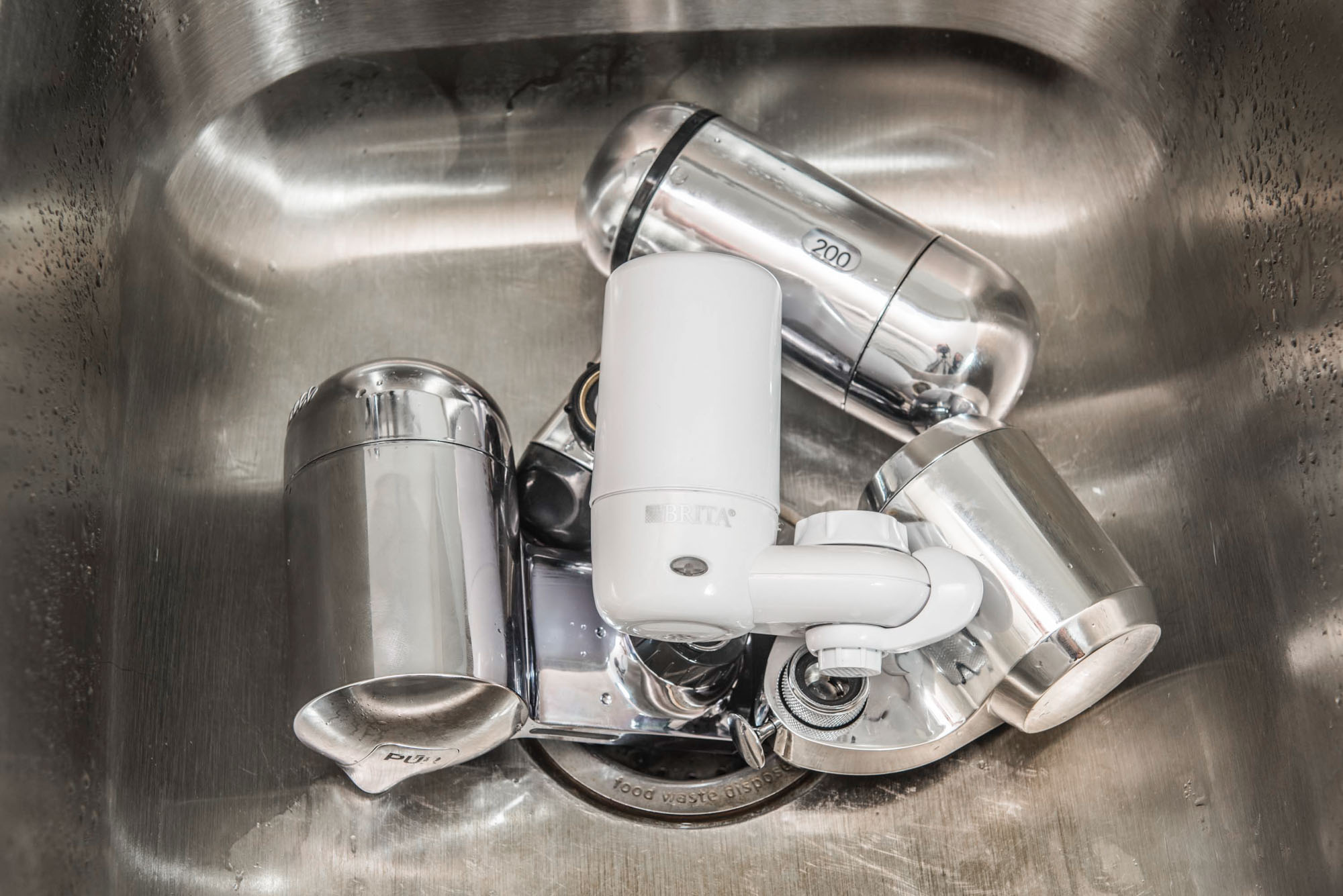
Faucet mount water filters are easy to install and work well. When we’re testing for our water bottle review and coffee maker review, it’s easy to grow tired of waiting for a pitcher to gravity-filter enough water. Faucet-mounted filters mean on-demand water without giving up any under-sink space for pressure tanks or filter manifolds that come with larger systems.
So long as you have a standard faucet spout with a threaded aerator — and not a pull-out hand-sprayer — any of these filters will install quickly and give you great-tasting water. They all use activated carbon blocks, so the results are similar.
The Brita – FF-100 is a clear winner despite the similar-tasting water. The body is compact and keeps mostly out of the way, and the extra spray option might even make this a handy faucet upgrade for some people. It’s still less expensive to run this filter than to buy Brita’s pitcher filters, so as long as you don’t need your water chilled by the fridge, this is a great option.
More Reviews
The 11 Best Expandable Garden Hoses
Joey's Garden Expandable Hose
The Best Alkaline Water Filter Pitchers
Brita - Longlast
The Best Filtered Water Bottles
Brita - BB10
RTIC - 30-Ounce Tumbler
Brita - Monterey with Longlast Filter
Thermos - Sipp
The 7 Best Water Filter Pitchers
Brita - 10-Cup Everyday Pitcher
Klean Kanteen - 20-Ounce Insulated
Hamilton Beach - 41020
Nuk - Magic 360


